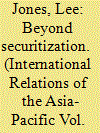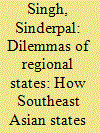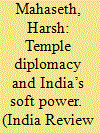| Srl | Item |
| 1 |
ID:
106462


|
|
|
|
|
| Publication |
2011.
|
| Summary/Abstract |
Since the late 1980s, the scope of security policy has widened dramatically to encompass a wide range of 'non-traditional' threats. Southeast Asian states have superficially appeared to embrace this trend, broadening their security discourse considerably. However, they are also often criticized for failing to translate this discursive shift into concrete regional cooperation to tackle these new threats. This article critiques the dominant theoretical framework used to explore the widening of states' security agendas - the Copenhagen School's 'securitization' approach - as unable to account for this gap due to its fixation on security discourse rather than practice. Drawing on state theory and insights from critical political economy, the article argues that the scope of regional security policy is better accounted for by the distinctive nature of state-society relations within Southeast Asia. The argument is advanced using case studies of Southeast Asian states' policies toward Burma, environmental degradation, and border conflicts.
|
|
|
|
|
|
|
|
|
|
|
|
|
|
|
|
| 2 |
ID:
164696


|
|
|
|
|
| Summary/Abstract |
This article examines contemporary perceptions and the corresponding responses of Southeast Asian states vis-à-vis India–China maritime competition. Specifically, it examines the cases of Singapore, Vietnam, and the Philippines. These countries provide useful cross-comparisons as, bilaterally, all three states relate uniquely to China and the maritime disputes in the South China Sea on the basis of two structural conditions – their formal security relationship with the US and whether they are a claimant state in the South China Sea dispute. The link between the range afforded by these three cases and the manner in which it drives their perceptions towards India–China maritime competition forms the core of this article. These three countries perceive differing levels of threat from China and have chosen a range of external balancing strategies to deal with these perceived threats. The nature of US–China and India–China security competition, the latter specifically in the maritime realm, structures the external balancing strategies they have pursued. There are, this article argues, important links between US–China and India–China strategic competition in structuring the external balancing strategies these countries pursue.
|
|
|
|
|
|
|
|
|
|
|
|
|
|
|
|
| 3 |
ID:
189432


|
|
|
|
|
| Summary/Abstract |
India’s pursuit of a position within the structure of Southeast Asian States has seen its most extensive ‘soft power’ campaign in all probability. One of the most effective forms of these soft power campaigns is its cultural diplomacy invoked through a shared cultural heritage with the Southeast Asian States. This cultural diplomacy takes the form of a multitude of instruments. However, the instrument of temple restoration as a form of cultural diplomacy is rarely analyzed irrespective of its steady presence in the last decades. This article is an attempt to fill in the gaps between the understanding of soft power and cultural diplomacy through temple restorations. The authors in this article examine India’s restoration of temples across the Southeast Asian States as a form of its cultural diplomacy and analyzes the effectiveness of the same as an instrument of soft power. In the first section, the authors examine the concept of ‘soft power’ and India’s efforts in the exercise of the same through the restoration of temples. In the second section, the author analyzes India’s exercise and development of ‘soft power’ with specific reference to how Buddhism enables India to develop its relations with Southeast Asian States. In the third section, the author examines whether India’s cultural diplomacy through its restoration of temples has actually had a positive impact in developing India’s relations with other Southeast Asian States. Finally, the authors analyze whether there is any merit to a continuation of such measures of its cultural diplomacy as an instrument of its soft power.
|
|
|
|
|
|
|
|
|
|
|
|
|
|
|
|